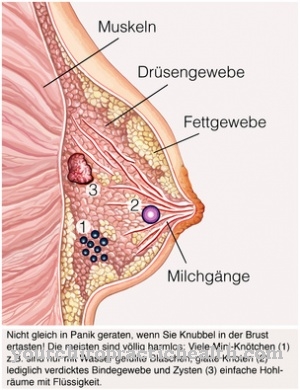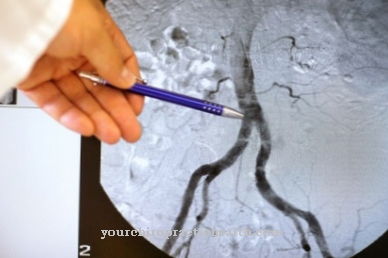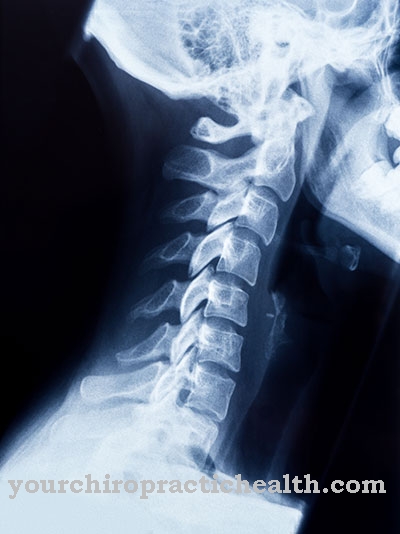As Oxyuriasis is called a pinworm infestation in humans. The pinworms hatch and mature in the intestine. The female worms reach full maturity around two weeks after fertilization and lay several thousand eggs outside the anus before they perish themselves. The pinworm does not need an intermediate host and usually does not cause any serious symptoms.
What is Oxyuriasis?

© jarun011 - stock.adobe.com
With Oxyuriasis becomes the infestation of a person with the so-called Pinworm called, an eight to thirteen millimeter long white nematode (female) whose eggs are ingested orally and cause the infestation. The pinworm passes through about three maggot stages in the intestine, but does not need an intermediate host. It is an unusually simple path of development and infection.
The pinworm passes through two to three larval stages in the intestine within two to three weeks and, after reaching sexual maturity and fertilization, settles in the appendix for another two weeks until the eggs reach their stage of maturity. The female worm then migrates towards the anus and leaves the anus mainly at night to lay its 5,000 to over 11,000 eggs. Then the female worm perishes.
The male pinworm dies after mating and is excreted with the stool.The eggs are surrounded by a special protein that, on the one hand, sticks the eggs to the skin near the anus and, on the other hand, causes itching, which causes the person affected to scratch himself - especially during sleep. As a result, some of the eggs are ingested with the fingers and can cause new infections or infections in other people.
causes
The pinworm, a nematode classified as a nematode with the Latin name Oxyuris vermicularis or Enterobius vermicularis, probably only affects humans. This means that only people infected with oxyuriasis or the excreted pinworm eggs come into question as sources of infection. The male worms perish after the act of copulation and are excreted. The female worms also die after laying eggs outside the anus, which is why the organism becomes worm-free on its own if eggs are not repeatedly taken in.
Since the eggs are laid mainly at night and are associated with the intense itching of the anus, the scratching often occurs unconsciously during sleep, so that the fingers and fingernails are contaminated with the tiny worm eggs. Another route of infection is the contamination of food with worm eggs or through spraying of contaminated aerosols. The worm eggs remain viable and infectious for up to three weeks under favorable environmental conditions.
Symptoms, ailments & signs
Oxyuriasis is initially accompanied by few symptoms. The most noticeable symptom is the nocturnal itching of the anus, which is triggered by special proteins in which the worm eggs are "packed" and with which the eggs practically adhere to the skin. If worm infestation persists, symptoms such as decreased appetite and facial pallor, weight loss, decreased performance and abdominal pain similar to those of appendicitis can occur.
In extreme cases, chronic diarrhea and rectal bleeding can occur. The pinworm does not penetrate other tissues or blood vessels, but in very rare cases the worm can infect the genital tract of girls and women and cause vulvovaginitis.
Diagnosis & course of disease
If itching in the area of the anus that occurs every night gives rise to suspicion of oxyuriasis, a good diagnostic option is to use a transparent adhesive strip to pick up possible worm eggs on the anus in the morning and examine them under a light microscope. If the outcome is negative, the process can be repeated for several days.
Another indication can be worms in the stool that can be seen with the naked eye and any dead female worms in the bed or nightwear. The course of the disease is usually unproblematic and hardly goes beyond loss of appetite and, in the worst case, pain reminiscent of appendicitis.
Complications
In most cases, oxyuriasis does not initially cause any particular discomfort or other symptoms. However, in the further course of this disease, those affected suffer from very severe itching in the anus, which mainly occurs at night. There is also a lack of appetite and thus weight loss and various deficiency symptoms.
Pallor in the face and a significantly reduced resilience of the patient are also associated with this disease. Oxyuriasis thus has a very negative effect on the quality of life of the person affected and reduces it enormously. Furthermore, the patients suffer from severe abdominal pain, which can often lead to depression or other psychological complaints.
Internal bleeding is also not uncommon and in some cases it can lead to anemia. In the worst case, it can also lead to appendicitis. This then has to be surgically removed. There are no particular complications. The symptoms can also be completely limited with treatment. The life expectancy of the patient is not affected.
When should you go to the doctor?
Itching in the genital area can indicate an infection with pinworms. A doctor's visit is indicated if the symptoms do not go away or if they get worse quickly. The symptoms usually appear during the night and can therefore be clearly assigned to oxyuariasis.
If small worms are noticed in the underwear or in the stool, a doctor should be consulted. Parents who notice behavioral or developmental disorders in their child should consult their pediatrician. Sleep disorders or skin changes in the genital area also indicate an infection, which must be clarified and treated by a doctor. Affected people should consult their doctor at an early stage and have the complaints clarified.
Otherwise life-threatening complications can occur. People who have come into contact with potentially infected people belong to the risk groups. Children who put a contaminated pacifier or finger in their mouth are also at risk and should see a doctor if the symptoms mentioned occur. The family doctor, pediatrician or a specialist for internal diseases can be consulted with the complaints. Other contact persons are the gynecologist or the urologist. During treatment, the patient must be closely monitored by a doctor so that the necessary countermeasures can be taken immediately in the event of any complications.
Therapy & Treatment
Oxyuriasis responds well to a single dose of antihelminthics, but the medication does not kill the eggs. Due to the risk of auto-infection from existing eggs and the development cycle of the pinworm, it is advisable to repeat a treatment 14 and 28 days after the initial treatment. Within a family, the family members should also be treated prophylactically in order to combat a possible initial infection in family members right at the beginning.
Initial infections are usually completely symptom-free in the first 4 to 6 weeks before the first female worms begin to lay eggs. Antihelminthics contain active ingredients that are specifically toxic to the metabolism of nematodes and flatworms such as tapeworms and flukes, but which are harmless to the human metabolism in the prescribed amount.
Before treatment with an antihelminthic drug, it should be known which type of worms caused the disease in order to be able to take targeted action. Some agents are only effective against nematodes and others only against flatworms.
Outlook & forecast
In the case of an infestation with pinworms, the prognosis is usually favorable. In most cases, oxyuriasis takes a positive course and only very rarely causes complications. However, there is a high relapse rate, especially among children. It is not uncommon for them to become infected again after a short time. In small children, the maggot eggs can penetrate directly from the anus into the mouth by sucking on the thumb or fingers.
Side effects from the treatment are rarely to be feared. Complications such as an infection of the female vagina with worm eggs, which develop there, rarely cloud the favorable prognosis. However, if there are any sequelae, they become noticeable as inflammation, pain, or discharge. In severe cases, there is a risk of impaired bowel functions. However, life-threatening intestinal perforations are very rare. The affected people also suffer from abdominal pain and stool retention. Usually, however, oxyuriasis does not pose a major risk to the patient's health.
However, the risk of further infection is high. Even with effective treatment, oxyuriasis often returns because other members of the family are often infected with the pinworms.
A longer healing period for oxyuriasis must be expected if the pinworm infection was discovered late. In such cases, the affected organs have to be rehabilitated.
prevention
The main preventive measure is strict hygiene. This is especially true for people within a family when a family member is affected. The hygiene measures consist of changing underclothes and, if possible, bed linen, and washing them in a boiling cycle in order to reliably kill any worm eggs and maggots that may be present. Particular care is taken in hand hygiene, which must be washed with soap after every possible contact and the fingernails meticulously worked with a nail brush.
Aftercare
With oxyuriasis, those affected usually have only a few direct follow-up measures available. With this disease, first and foremost, a very early and above all quick diagnosis is necessary so that there are no further complications or complaints. Therefore, the person affected should ideally consult a doctor at the first signs and symptoms.
Most patients rely on various medications to relieve these symptoms. The exact instructions of the doctor should always be followed in order to identify and treat possible side effects at an early stage. Furthermore, regular checkups are very important even after successful treatment in order to prevent re-infection of the oxyuriasis.
Most sufferers should follow a healthy lifestyle with a balanced diet to counteract the symptoms. The person concerned should drink a lot to support the body. As a rule, oxyuriasis can be treated relatively well by a doctor, so that follow-up measures are no longer necessary. In general, a high standard of hygiene should be maintained.
You can do that yourself
Fortunately, once the pinworms are diagnosed as causing the nighttime itching, oxyuriasis can be easily treated. During treatment, people should be careful not to scratch their anus, even at night while sleeping. So that children can stick to it, pajamas such as those offered for children with neurodermatitis are helpful. They have mittens on the sleeve ends that the child cannot slip out of. At night, children can only scratch fabric with cloth and not bring worm eggs from their hands to their mouths.
Because the worm eggs can also survive outside the intestines for a good three weeks, strict hygiene within the family is advisable. Underwear, towels and bed linen should be changed every day and washed on a hot wash cycle. This is the only way to ensure that the maggot eggs are not also transmitted via substances.
Personal hygiene is also important, especially in the anal area. PH-neutral washing and care products are recommended here. If the anus has already been scratched, nourishing creams help, with which the region can be creamed once or twice a day. Baby creams or wound and healing ointments are the first choice here. Gels that contain light-colored sulfonated shale oil are also recommended because they have an antimicrobial and wound healing effect.



.jpg)
.jpg)



















.jpg)



